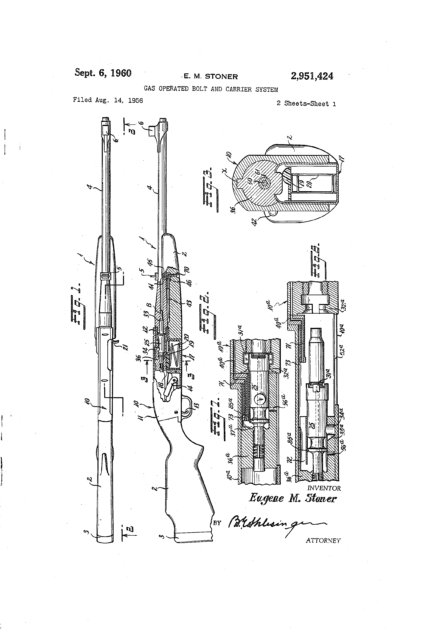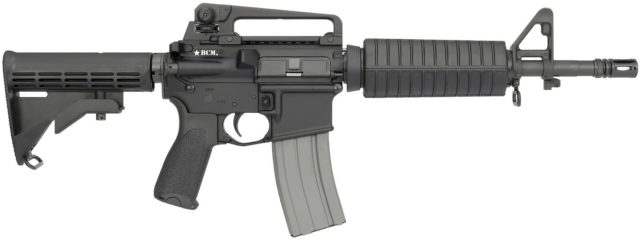War History online proudly presents this Guest Piece from Sam Bocetta
If the Bald Eagle represents the land of the free than the AR-15 represents the Marines and US Armed Forces. What most people don’t understand is that AR-15 is actually a brand name just like Nike or Coke.
As the name “AR-15” grew in popularity so did its reputation as a reliable all-American firearm. The AR-15 is now manufactured by hundreds of companies throughout the US as a civilian equivalent for the military M-16. Its synthetic and aluminum design have made it a favorite for shooting enthusiasts and gun collectors who want a highly modifiable weapon.
In recent years it has enjoyed an upsurge of popularity as many smaller companies offer tactical accessories for their ARs. In a recent article on Wired, the AR was described more as a gadget than an actual gun.
How did a weapon designed for widespread military use become a civilian toy?
In today’s article, we’re going to look at a brief history of the AR-15 to better understand its origins.
Where Did the AR-15 Start
To understand the AR gun we first need to know what the “AR” part means. You might be thinking, that’s easy – it stands for Assault Rifle. Wrong!

AR stands for ArmaLite, after the company who invented the original line of ARs including the AR-1, AR-5, AR-7, AR-10 and finally the 16 and 17. It was Colt who got the final popular AR-15 design right, borrowing off the previous ArmaLite design and build.
The AR-15 was released in 1964 as a remake of the popular Army M16. The original version was known as the AR-15 Sporter which had a 20 inch barrel and a smaller 5-round magazine. Colt quickly expanded this line into a huge variety of other AR-15 models specially designed for law enforcement and private security.
US Patent 2951424
This patent act was crucial to making the AR function in a unique way. The patent described how the cycling mechanism worked, specifically that the bolt carrier functioned just like a movable cylinder while the bolt was actually a stationary piston. The original patent called this technology a DGI or a direct gas impingement system.

Eugene Stoner and the Civilian AR-15 Market
ArmaLite has some trouble first marketing the product to police forces who at that time were still using pump action shotguns for civilian security and defense work. ArmaLite design allowed their new AR models to contain a larger percentage of plastic and other lighter materials. The lighter build allowed them to expand into new markets rapidly.
One of the chief engineers involved in the AR project was Eugine Stoner who was the Chief Engineer at Armalite. It was under Eugene’s work that Armalite got the first USAF contract that gave them the funding needed to scale their operation and revamp the existing design.
The USAF wanted a smaller light rifle that could be hidden in fighter pilots’ cockpits in case they went down. The solution was the AR-5 which was a smaller modular rifle utilizing a .22 Hornet bolt action magazine. The entire unit could be disassembled quickly and effectively.
This modular design made the AR-5 completely waterproof and very easy to clean. As it was designed for maximum portability it was built using the simplest design available. The USAF was so pleased with the design that they ordered thousands of AR-5s. As the production facilities were set up this also gave ArmaLite the means to start manufacturing and building civilian market AR-15s en masse.
The M1 Garand
While the AR-5 definitely didn’t look like the AR-15 we have now the M1 Garand was a closer candidate. The M1 was one of the go-to weapons of American soldiers in WW2. It was cheap to manufacture and fairly reliable. The only issue was the original design wasn’t extensively field tested. Soldiers who used the M1 complained about the lack of cartridges in the magazine and also the heavyweight. The M1 weighed in at 10 ½ pounds which was a lot of weight to be carried around.

As the Army looked for a replacement for the M1, they looked to Springfield Armory and the T-48. Both guns were based on a popular FAL design system.
ArmaLite once again came to the rescue with a design for their AR-10 which was a new rifle with very similar caliber yet an improved lightweight body made of aluminum receivers. It was also one of the first guns to have a plastic stock and handguards. Another design feature modified the barrel to the receiver allowing for lighter materials to be used for the receiver end. It weighed 7 pounds and worked just as well.
3 pounds might not seem like a big difference, but when you’re carrying heavy equipment around all day it definitely matters.
The Army loved the design and after some negotiation scheduled the AR-10 to be produced for select Marine units throughout the US.
ArmaLite Becomes Colt
Armalite was eventually acquired by a Dutch company – Artillerie Inrichtingen and sold throughout Europe. For reasons that I don’t know, it didn’t do well and sales were much lower than expected. This resulted in the AR licenses being eventually sold to Colt firearms.
Colt worked under the brand name Armalite quickly releases multiple models of the AR-15 including the AR-7 which uses a long rifle caliber made specifically for police snipers. In 1963 the USAF finally makes the AR-15 a standard issue weapon and over 85,000 units are sold.
The Modern AR 15

The modern AR-15 went through many transitions to become the weapon it is today. From a military weapon designed for downed Air Force Pilots to a police weapon to finally a civilian gun enthusiast’s most sought after gun it has gone through quite the journey.
American innovation for AR-15s has continued to develop with hundreds of companies offering everything from cheap laser red dot sights to advanced AR-15 optics. The AR is a perfect example of how military innovation and research trickles down to civilian applications and usage.
